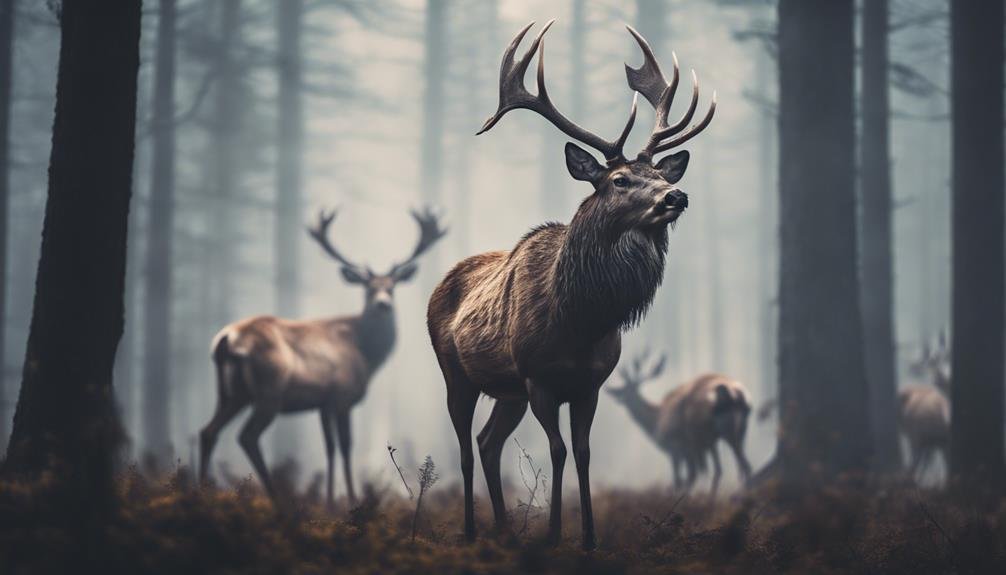As a hunter, I know that understanding the tag allocation system is essential to maximizing my chances of securing a coveted tag. Bonus points, preference points, and resident vs. non-resident tags all play a role in determining the odds. I've learned that each state has its unique approach to tag allocation, and grasping these differences is imperative. I'll need to stay informed about tag allocation systems, alternative strategies, and resources to increase my chances of success. By digging deeper, I can uncover the secrets to big game tag battles and finally land that elusive tag.
Key Takeaways
- Understanding tag allocation systems is vital to maximizing chances of drawing a tag, as each state has its unique approach.
- Bonus points and preference points systems reward repeat applicants, increasing their drawing odds, but don't guarantee a tag.
- Resident and non-resident tags have varying restrictions, with some states capping non-resident tags at a certain percentage.
- Alternative strategies, such as tag flexibility, hunter mindset, and applying in multiple states, can increase chances of securing a high-quality hunt.
- Staying informed, prepared, and flexible is key to success in big game hunting, with resources like MeatEater providing exclusive content and insights.
Understanding Tag Allocation Systems
When applying for big game tags, understanding the allocation system is essential, as it determines the likelihood of securing a coveted tag. As a hunter, I need to grasp how state agencies manage wildlife populations and allocate tags. The number of available licenses is based on the sustainable harvest of animals, ensuring conservation efforts aren't compromised. Tags are then distributed through various systems, including pure lotteries, bonus point systems, and preference point systems. Each state has its unique approach, and understanding these systems is vital to maximizing my chances of drawing a tag. By recognizing the intricacies of tag allocation, I can tailor my application strategy and make informed decisions about which tags to pursue.
How Bonus Points Work
As I explore the world of bonus points, I realize that these systems reward repeat applicants with additional chances to draw a tag, increasing my odds of securing a coveted hunting opportunity. Bonus points dispel the myth that it's impossible to draw a tag without years of applications. Statistically, even with zero bonus points, I still have a small chance of drawing a tag. The bonus point system is designed to give repeat applicants an advantage, but it's not a guarantee. Montana, for instance, squares bonus points, dramatically increasing my drawing odds. By understanding how bonus points work, I can debunk common myths and focus on improving my drawing odds.
Preference Point Systems Explained
With a different approach than bonus points, preference point systems reward repeat applicants by allocating tags to those with the most points, creating a sense of urgency to accumulate points over time. This system encourages hunters to apply consistently, as those with the most points have a higher chance of drawing a tag. I've seen some hunters engage in point hoarding, applying for multiple units and species to accumulate points, even if they're not serious about hunting those areas. This strategy can lead to hunting fatigue, as applicants feel pressured to apply every year, regardless of their true intentions. Understanding preference point systems is essential for developing a successful tag application strategy. By knowing how points are allocated, I can maximize my chances of drawing a coveted tag.
Resident Vs. Non-Resident Tags
I've often wondered how state agencies allocate big game tags between residents and non-residents, and the varying restrictions that come with these different tag types. As I cross state borders, I notice the hunter influx changes, and I'm curious about the reasoning behind tag allocation. In Montana, for instance, non-resident big game tags are capped at 10% of the total available tags. In contrast, Colorado issues up to 35% of tags to non-residents, while Wyoming allows non-residents to compete for tags through the draw system. Understanding these differences is essential for hunters like me, as it affects our chances of securing a tag. By grasping the nuances of resident vs. non-resident tags, I can tailor my application strategy to maximize my odds of success.
Alternative Tag Strategies
Beyond applying in multiple states, dedicated hunters can employ alternative strategies to increase their chances of securing a high-quality hunt, such as identifying underrated tags that require minimal points or capitalizing on overlooked units. By adopting a flexible mindset, hunters can explore different options to maximize their hunting opportunities.
Three alternative strategies exist:
- Tag Flexibility: Apply for tags in multiple states or units to increase your chances of drawing a tag.
- Hunter Mindset: Focus on the hunting experience rather than a specific species or unit, and be open to trying new things.
- Overlooked Units: Identify units with lower demand or fewer applicants to increase your chances of drawing a tag.
Managing Points and Tags
As I navigate the complex world of big game tag allocations, managing my points and tags strategically becomes essential to securing a coveted hunting spot. Effective point management is vital, as it directly impacts my chances of drawing a tag. I focus on accumulating points in states with bonus or preference point systems, maximizing my odds of success. A well-thought-out tag strategy is also essential, as it allows me to prioritize my applications and allocate my points wisely. By balancing my point management and tag strategy, I can increase my chances of securing a tag and enjoying a successful hunting season.
Tag Application Strategies
When developing a tag application strategy, multiple factors must be borne in mind, including the number of points accumulated, the popularity of the unit, and the overall competitiveness of the draw. I consider these factors to maximize my chances of securing a coveted tag. To optimize my strategy, I:
- Prioritize units with high success rates and minimal points required.
- Time my applications to coincide with peak draw periods.
- Diversify my applications across multiple states and units to increase overall odds.
Overlooked Tags and Opportunities
I scour the draw odds and harvest data to identify underrated tags that require minimal points, providing a higher likelihood of securing a high-quality hunt. These Hidden Gems often fly under the radar, offering a better chance of drawing a tag. I focus on Sleepy Units that are overlooked by other hunters, yet still offer exceptional hunting opportunities. By applying for these underrated tags, I increase my chances of securing a tag and experiencing a memorable hunt. I must do my research and stay informed about draw odds, harvest data, and unit trends. By doing so, I can uncover these hidden opportunities and make the most of my tag applications.
Leftover Tags and Raffles
After securing a tag through the draw, I turn my attention to leftover tags, which offer a second chance to add hunts to my calendar. These tags can be a great way to capitalize on unexpected opportunities. Here are three key considerations for leftover tags and raffles:
- Raffle Strategy: Don't underestimate the power of raffles in securing hard-to-draw tags. Develop a raffle strategy to increase your chances of winning a coveted tag.
- Tag Surprises: Leftover tags can lead to unexpected hunting opportunities, so be prepared to adapt your plans and take advantage of surprise tags.
- Last-Minute Planning: Be prepared to plan and prepare quickly if you secure a leftover tag or win a raffle, as these opportunities often arise at the last minute.
Maximizing Hunting Time
By strategically applying for tags in multiple states and leveraging leftover tags and raffles, I can maximize my time in the field each fall. As a hunter, I know that flexibility is key to extending my hunting season. By applying for tags in multiple states, I can increase my chances of securing a high-quality hunt. This approach allows me to hunt in different regions, taking advantage of varying seasons and game populations. By combining leftover tags and raffles, I can extend my hunting season, making the most of my time in the field. With a flexible hunting strategy, I can enjoy a longer hunting season, exploring new territories and experiencing the thrill of the hunt.
Navigating State Tag Systems
Understanding the intricacies of state tag systems is vital for big game hunters, as each state's unique allocation process can greatly impact hunting opportunities. As I delve into the world of big game hunting, I've come to realize that each state has its own "State Secrets" when it comes to allocating tags. To navigate these systems, I've learned to focus on three key areas:
- Tag allocation methods: Understanding whether a state uses a lottery, bonus point, or preference point system is crucial in determining my chances of drawing a tag.
- Resident vs. non-resident tags: Knowing the rules and restrictions for non-resident tags can help me strategize my applications.
- Alternative strategies: Identifying underrated tags and applying in multiple states can increase my chances of securing a high-quality hunt, avoiding the "Hunting Frenzy" that can come with popular tags.
Resources for Big Game Hunters
As a big game hunter, I've found that having the right gear and knowledge is essential to success in the field, and that's why I rely on resources like MeatEater, which provides access to exclusive content, including articles, podcasts, and videos, to help me stay informed and prepared for my next hunt. I also invest in high-quality hunting gear, such as the Argali Outdoors game bag set, to guarantee I'm equipped for any situation. Having the right gear and knowledge is only half the battle, though – having a solid network of hunting buddies is imperative too. Sharing tips and strategies with fellow hunters helps me stay ahead of the game and learn from their experiences. By leveraging these resources, I'm able to stay focused on my hunting goals and make the most of my time in the field.
Frequently Asked Questions
Can I Transfer My Bonus Points to Another State?
"I've researched bonus point transfer rules, and unfortunately, most states don't allow point sharing or bonus transfer between states, so I'll need to start from scratch in a new state."
How Do I Know Which Tag Allocation System a State Uses?
When researching a state's tag allocation system, I check their wildlife agency's website, like Montana Fish, Wildlife, and Parks, which outlines their bonus point system, ensuring I understand the state regulations and allocation methods before applying.
Can Non-Residents Apply for Leftover Tags?
As I analyze tag availability, I find that some states allow non-residents to apply for leftover tags, providing out-of-state opportunities, while others restrict them to residents, necessitating thorough research for successful application strategies.
Are Preference Points Transferable to Another Hunter?
I've got a million points accumulated over the years, but can I transfer them to mySibling's account for our epic family hunting trip? Unfortunately, no, preference points are typically non-transferable between hunters, but some states allow point inheritance for family members.
Do All States Offer Raffles for Special Tags?
I've researched raffles for special tags, and it seems not all states offer them; some states, like Arizona, offer raffle opportunities, while others might not, so I'll need to check each state's regulations for Raffle Accessibility and Tag Limitations.
Conclusion
As I wrap up my research, I'm reminded that securing a big game tag is a long shot – literally. Did you know that in some states, the odds of drawing a tag are as low as 1 in 100? Despite the challenging odds, understanding the intricacies of tag allocation systems and employing smart strategies can substantially boost my chances of success. With persistence and the right approach, I'm ready to beat the odds and fill my tag.









